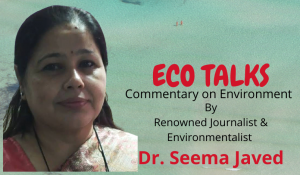 Varanasi, UP showed upto 50% highest reduction.
Varanasi, UP showed upto 50% highest reduction.
Today it has been three years since the National Clean Air Programme (NCAP) was implemented across India to reduce particulate matter levels in 132 cities by 20-30%, data shows there has been little or no progress on ground.
However An analysis of air quality monitoring data from the Continuous Ambient Air Quality Monitoring System (CAAQMS) shows that Varanasi, Uttar Pradesh recorded the highest reduction. However only 36 out of the 132 cities met the criteria.
The union government launched the National Clean Air Program (NCAP) on 10th January 2019 to address air pollution in 102 cities, to which 20 more cities were added later in the year and 10 more subsequently.
These 132 cities are called non-attainment cities as they did not meet the national ambient air quality standards (NAAQS) for the period of 2011-15 under the National Air Quality Monitoring Program (NAMP). The country’s current annual safe limits for PM 2.5 and PM 10 are 40 micrograms/per cubic metre (ug/m3) and 60 micrograms/per cubic metre.
The NCAP has set a target of reducing key air pollutants PM10 and PM2.5 (ultra-fine particulate matter) by 20-30% in 2024 taking the pollution levels in 2017 as the base year to improve upon.
An analysis of the government’s air quality data shows that not only have most non-attainment cities reduced PM 2.5 and PM 10 levels only marginally but some have also recorded an increase.
An analysis of air quality monitoring data from the Continuous Ambient Air Quality Monitoring System (CAAQMS) shows thatVaranasi’s annual PM 2.5 levels reduced 52% from 91 ug/m3 in 2019 to 44 ug/m3 in 2021 and its PM 10 levels reduced 54% from 202 ug/m3 in 2019 to 93 ug/m3 last year. The other cities that have already met its reduction target of at least 20% were Hubli, West Bengal where PM 2.5 and PM 10 reduced by 42% and 40% respectively and Talcher, Odisha which saw a PM 2.5 reduction of 20% and PM 10 reduction of 53%. Ahmedabad recorded a 26% decrease in PM 10 levels. On the other hand, Navi Mumbai’s PM 2.5 levels increased from 39 ug/m3 to 53 ug/m3 and PM 10 levels increased from 96 ug/m3 to 122 ug/m3 from 2019 to 2021. Three years later, none of the analysed non-attainment cities have met the CPCB’s PM 10 safe standard of 60 ug/m3.
Most Polluted in PM2.5
Ghaziabad, Uttar Pradesh with annual PM 2.5 levels above 100 remained at the top of the table in the most polluted cities except 2020 when Lucknow, Uttar Pradesh ranked first with an annual PM 2.5 level of 116. Most other cities like Noida, Delhi, Moradabad and Jodhpur saw only a marginal dip in PM 2.5 levels and remained in the top 10 polluted non-attainment cities throughout the year. Varanasi with its drastic dip in PM 2.5 levels went from the fifth rank in 2019 to the 37th in 2021. While four of the top 10 polluted cities were from Uttar Pradesh, West Bengal had three cities – Howrah, Asansol and Kolkata – on the list.
Also Read : Lucknow emerge champions in AIMPL
Also Read : Over 15-crore UP voters to elect 403 MLAs
Least polluted in PM2.5
Vijaywada in Andhra Pradesh was the least polluted among the non-attainment cities with a PM 2.5 annual average of 24 ug/m3. However, data for the next two years was not available for the city and hence tracking its progress was not possible. Several cities from Maharashtra featured on the list in 2019, Mumbai, Navi Mumbai, Nashik and Chandrapur recorded an increase in PM 2.5 levels and slipped from the table in 2021. For instance, Mumbai PM 2.5 levels were up from 34 ug/m3 in 2019 to 53 ug/m3 in 2021, an increase of 38%. On the ranking table, Mumbai slipped from seven in 2019 to 15 in 2020 and 27 in 2021. Despite the Covid-19 resultant lockdown, the city’s annual PM 2.5 levels were higher in 2020 as compared to 2019
Most polluted in PM10
Eight cities – Ghaziabad, Delhi, Noida, Varanasi, Moradabad, Jodhpur, Mandi Gobingarh and Howrah – out of the 10 most polluted for PM 10 also featured on the most polluted for PM 2.5 as well. Of the 10 cities, four are from Uttar Pradesh. Like for PM 2.5, Ghaziabad was on the top of the list of most polluted cities for PM 10 levels as well. The city only saw a marginal reduction in PM 10 levels from 243 ug/m3 to 238 ug/m3. Once again, Varanasi’s dip in PM 10 levels resulted in it improving its ranking. Despite the reduction, the PM 10 levels continue to remain way above the CPCB permissible limit of 60 ug/m3. Similarly, Talcher saw its PM 10 levels dip from 178 ug/m3 in 2019 to 84 ug/m3 in 2021.

Image: Comparison of PM 10 levels for the 10 most polluted non-attainment cities
Data Source: Continuous Ambient Air Quality Monitoring System (CAAQMS). Compiled by Respirer Living Sciences
Least polluted in PM10
While Chennai, Tamil Nadu was the least polluted in terms of PM 10 in 2019, an increase of levels from 55 ug/m3 to 58 ug/m3, it did not hold on to its spot in 2021. The other city which saw a drastic dip in ranking (from 7 to 26) was Mumbai where PM 10 increased from 82 ug/m3 in 2019 to 104 ug/m3. With a PM 10 reduction from 89 ug/m3 in 2019 to 53 ug/m3 in 2021, Hubbali improved its ranking from 2 to 10.

Image: Comparison of PM 10 levels for the 10 least polluted non-attainment cities
Data Source: Continuous Ambient Air Quality Monitoring System (CAAQMS). Compiled by Respirer Living Sciences
The Ministry of Environment, Forests and Climate Change (MoEF&CC) and Central Pollution Control Board (CPCB) are leading the program at the national level. At the state level, State Pollution Control Boards (SPCBs) are mandated to develop the city action plans and monitor their implementation by identified departments and agencies.
 Jubilee Post News & Views
Jubilee Post News & Views





